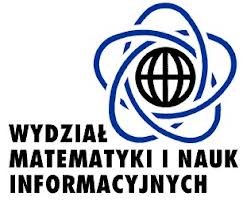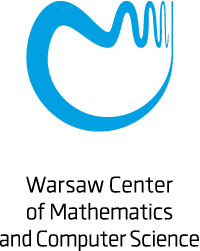Program
The program (version from June 10) is available here.
Onsite registration and an informal meeting will take place on Thursday, June 19, between 18:00 and 21:00 at the conference venue (first floor, room number 105A).
Another possibility for registration is on Friday, June 20, between 8.15 and 8.40 and during the first coffee break at room 105A.
All participants are cordially invited to a conference dinner on Friday, June 20, at 19:00 at "La Cantina" (address: Nowy Świat 64).
Invited talks
Aleš Drápal
An introduction to latin bitrades
Abstract:
The easiest way to define a latin bitrade is to say that it is a difference set of two latin squares (quasigroups) of the same order. However, these simply definable structures have many facets. Amongst others, they can be interpreted as black-white triangulations of surfaces that are vertex 3-colourable, or as triples of permutations that yield the identity when composed (and satisfy an additional condition). There exists an important connection to dissections of equilateral triangles. Furthermore, quite a lot is known about the embeddings of latin bitrades into group tables (they always exist if the latin bitrades is of genus zero), and about the generation schemes of latin bitrades. The talk is planned to be of expository nature.
Mai Gehrke
Topological algebras on Boolean spaces as dual spaces and applications in formal language theory
Abstract:
Our main result is that any topological algebra based on a Boolean (or Priestley) space is the extended Stone dual space of a certain associated Boolean algebra (or distributive lattice) with additional operations. A particular case of this result is that the profinite completion of any abstract algebra is the extended Stone dual space of the Boolean algebra of recognizable subsets of the abstract algebra endowed with certain residuation operations. These results identify a connection between (ordered) topological algebra as applied in algebra and Stone-Priestley duality as applied in logic, and show that the notion of recognition originating in computer science is intrinsic to profinite completion in mathematics in general. This connection underlies a number of recent results in automata theory including a generalization of Eilenberg-Reiterman theory for regular languages and a new notion of compact recognition applying beyond the setting of regular languages.
Katarzyna Słomczyńska
Fregean varieties
Abstract:
A variety of algebras with a distinguished constant term 1 is called Fregean if it is 1-regular and congruence orderable. Many natural examples of such varieties come from the algebraization of fragments of classical, intuitionistic, or intermediate logics. The structure of congruence permutable (CP) Fregean varieties is quite well understood. In particular, we know that every CP Fregean variety consists of algebras that are expansions of equivalential algebras, that is algebras that form an algebraization of the purely equivalential fragment of the intuitionistic propositional logic.
Every Fregean variety V fulfills the commutator identity (C1). In fact it satisfies the even stronger condition (SC1), from which it follows that if V is CP, then every finite algebra A from V is polynomially rich, i.e. every operation on A preserving congruences of A and their commutators is already a polynomial of A. Moreover, the algebra itself can be recovered from its congruence lattice expanded by the commutator operation up to polynomial equivalence. This leads to Fregean frames, a notion that generalizes Kripke frames for intuitionistic propositional logic. For some CP Fregean varieties one can find Fregean frames for all finitely generated free algebras and use this construction to determine the free spectrum of variety.
Jonathan D. H. Smith
Quantum quasigroups
Abstract:
Over the last few years, two independent extensions of group theory have been developed: Hopf algebras (or "quantum groups"), and quasigroups (or "nonassociative groups"). These two developments have recently been unified by the concepts of quantum quasigroups and quantum loops: nonassociative generalizations of Hopf algebras, with a much simpler, but still self-dual axiomatization. They include previous attempts at extending Hopf algebra structure to nonassociative situations, in particular the Moufang-Hopf algebras of Benkart et al., and the H-bialgebras of Pérez-Izquierdo.
Quantum quasigroups and loops are formulated entirely in the context of a symmetric, monoidal category. Thus the concepts are preserved by symmetric, monoidal functors between such categories, for example the free algebra functor from the category of sets with direct products to a variety of entropic algebras with tensor products, or the underlying set functor from the category of abelian groups with direct sums to the category of sets with direct products. This general approach gives immediate access to a rich store of examples, such as group and loop algebras. It is shown that (Moufang-)Hopf algebras reduce to quantum loops, while sufficient conditions are given for an associative and coassociative quantum loop to augment to a Hopf algebra.
Ágnes Szendrei
Dualizable algebras with parallelogram terms
Abstract:
Natural Duality Theory investigates categorical dualities that are mediated by finite algebras.
One of the main goals of the theory is to identify those finite algebras that can serve
as character algebras for a duality. Such algebras are called dualizable.
The talk will focus on the following sufficient condition for dualizability: If A is a finite algebra
that generates a residually small variety with a parallelogram term, and all subalgebras of A
satisfy a new condition I call the "split centralizer condition", then A is dualizable. This theorem yields yet another proof of the dualizability of any finite algebra with a near unanimity term (Davey—Werner), any finite group or commutative ring in a residually small
variety (Nickodemus and Clark-Idziak-Sabourin-Szabo-Willard), but more importantly, it proves also that every finite module and every finite ring in a residually small
variety is dualizable.
Mikhail Volkov
Algebraic constructions for expanders
Abstract:
A finite graph is said to be a good expander if it has low degree but strong connectivity properties. The latter condition means that every set of vertices that is not "too large" has a "large" boundary. The original motivation for expanders is to build economical and robust networks: robustness is achieved via strong connectivity while the low degree property ensures that costs grow linearly with size. Later expanders have found extensive applications in designing algorithms and error correcting codes; they have also been used in proofs of many important results in computational complexity theory and in cryptography.
While it is not hard to prove that expanders exist (a random graph is a good expander, for instance), an explicit construction for an expander is very far from being obvious. The best explicit constructions are provided by group-theoretic tools: it turns out that Cayley
graphs of finite groups with respect to some relatively small generating sets often constitute good expanders (Alon-Roichman theorem). In this talk, we discuss this nice and important application of classical algebra to modern computer science.


